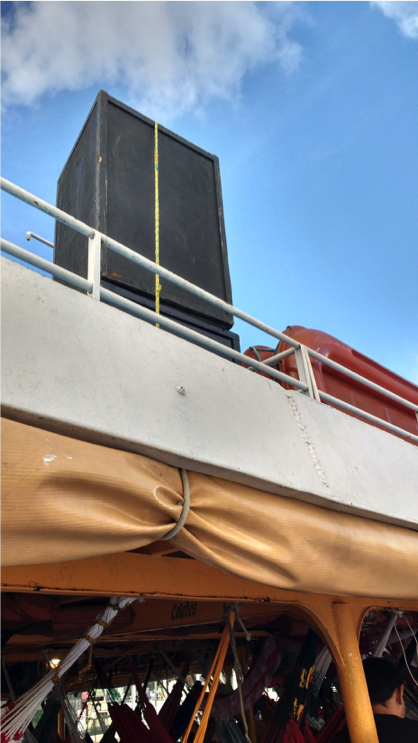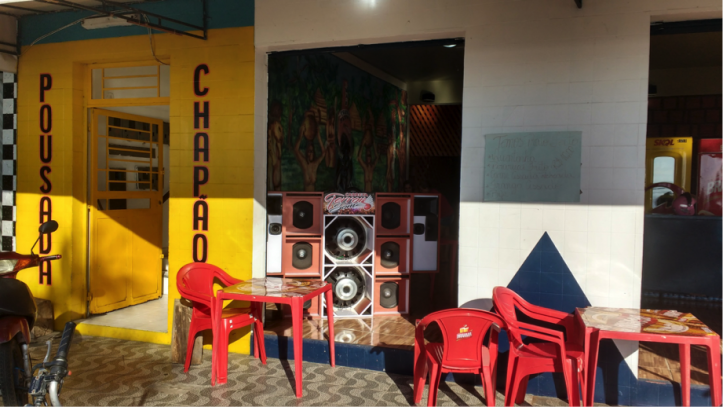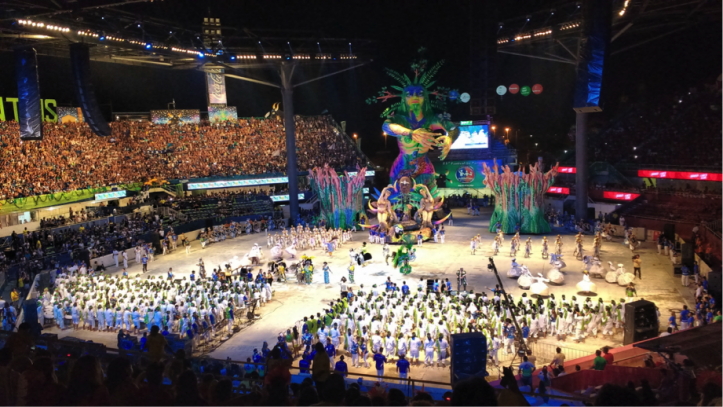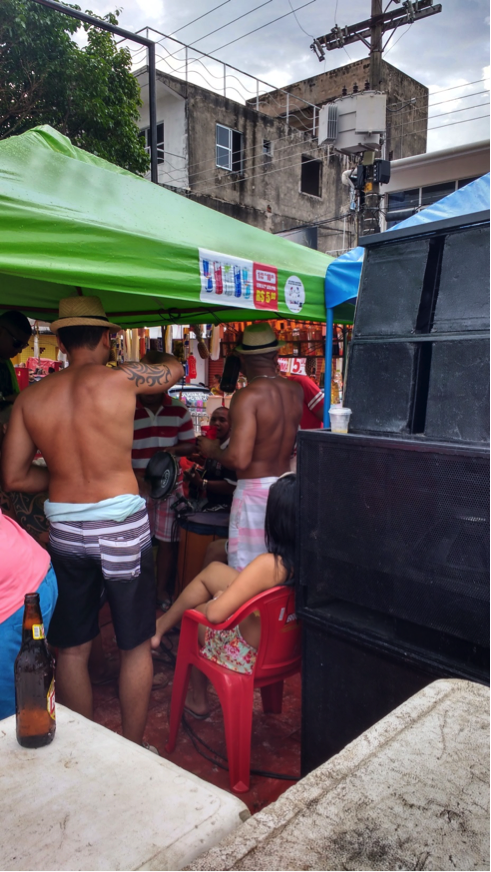Sounding Repetition and Change: Loudspeakers and the Folklore Festival of Parintins, Brazil

Introduction
The Folklore Festival, or Boi-Bumbá Festival, is an annual celebration that takes place in Parintins, a city located on the Tupinambarana island in the state of Amazonas, Brazil. Every June, 50,000 – 80,000 tourists and vendors from various social classes flock to the festival, adding substantially to the municipality’s population of 112,000, and bringing with them a vast array of objects, including loudspeakers.[1] As such, the city becomes a major site of social and cultural exchange. Here, I will share some initial observations from my research into the circulation of loudspeakers in this festival. In dialogue with Steven Feld’s ‘acoustemology’ and his preoccupation with ‘what is knowable, and how it becomes known, through sounding and listening’ (2015:12), I propose that multiple listening histories coexist in this festival in the North of Brazil. In the last two decades, there appears to have been a change in the music genres that sound in the streets of Parintins in June. By building on different accounts by visitors and locals of how the festival sounded in 2016, I will argue that in listening to the festival, different notions of what is past and what is present are at stake.
Sonic amplification and the festival
The Folklore Festival is one of many forms that the ‘Brincadeira do boi’ (‘the merrymaking of the ox’) has taken in Brazil. In all its variations, the merrymaking always addresses a traditional form of popular theater: an artefact-ox, animated by people inside it, dances, dies, resurrects, and is surrounded by a group of players (who in Portuguese are called brincantes). The revelry always involves music, dance and drama and is built around rivalry (Cavalcanti 2006). In the case of Parintins, this popular tradition has turned into three nights of spectacular competition between two groups: Boi Caprichoso, represented by a black artefact-ox and the color blue, and Boi Garantido, represented by a white artefact-ox and the color red. The Festival was created in 1965, as a way of institutionalizing merriments that had been taking place in the streets of the city since the early twentieth century. Though it began in 1965 as a feast for the community, by the end of the twentieth century it had reached massive proportions and attracted private sponsors, becoming, in the words of Cavalvanti, ‘a major expression of popular culture in North Brazil, drawing thousands of people not only from the state capital of Manaus and nearby cities but also from all over the country’ (2000:1019).
I first attended the festival in June 2016, travelling from Manaus, the capital of the state, in a boat with around 400 passengers. Throughout this 20-hour journey, I was surprised by multiple tunes sounding loudly and simultaneously. After a brief walk around the boat I realized that there where at least three powerful sonic amplifying sources travelling with me: a loudspeaker tied to the top of the boat, another one carried by a group of travelers in the resting area, and two tall loudspeakers near the bar on the third floor. These speakers all played different toadas: tunes specially created every year for the competing groups of the festival. Toadas draw on Amazonian legends, indigenous rituals and aspects of Amazonian daily life (Batalha and Oliveira Montardo 2015) and are an important component of the festival’s local cultural identity.

Fig. 1: Loudspeaker on top of the boat
When I arrived in Parintins, the boat trip turned out to be but a preparation for the festival to come in land. Parintins had its bohemian streets occupied by people drinking and celebrating night and day. Part of the festival’s festive vibe is conveyed by sonic excess, as noted also by Brazilian anthropologist Maria Laura Cavalcanti:
There is no silence, not even the gentle sound of the river: everything is immersed in a musical environment that is omnipresent as it is confusing, because all the small bars (…) and family houses play incessantly the toadas of their preference (2000:1035).

Fig. 2: Paredão (wall of loudspeakers) inside a bar, in the old port area
Loudness and the coexistence of multiple tunes have thus been a defining characteristic of the festival since at least the 2000s, and one that extended from water to land.[2] However, contrary to Cavalcanti’s experience of the festival in 2000, in 2016 sonic simultaneity was not only about toadas. I noticed that people partied and gathered around a variety of popular genres not thematically related to the festival: pagode, sertanejo, tecnobrega, forró and others.
Loudspeakers in the center of Paintins (video by author)
The contrast between my perception of the festival in 2016 and Cavalcanti’s account in 2000 leads to some questions: has the festival changed sonically throughout time? When did such diversity of music genres become part of it? During both of my visits to Parintins, in 2016 and 2017, I got in touch with local inhabitants of the city, street vendors, and visitors who provided me different accounts on the festival. There were heated debates over the extent to which toadas should or should not coexist with other popular music genres. Perceptions of how the city used to sound in previous years also varied.
The tunes that one listened to while walking in Parintins were simultaneously amplified, but they came from loudspeakers with different capabilities. Those objects distributed loudness and repertoire in ways that allowed for different listening experiences depending on one’s situated positionality. I will now share some ethnographic vignettes from my visit to Parintins in 2016 that show how a local inhabitant of the city and a visitor dealt with the festival’s sonic transformation in different ways. It makes no sense to wonder about the sonic transformations of the festival without acknowledging that coexistent listening bodies may listen to different festivals.
Some ethnography of listening
During the second day of the festival I watched the spectacle from TVs in bars next to the Bumbódromo, a stadium that has hosted the official competition since 1988. There, I could hear two categories of loudspeaker at work: 1) loudspeakers facing the streets, that worked independently of each other and that amplified a variety of music genres coming from bars and TVs around me; 2) loudspeakers that were inside the Bumbódromo, and worked in cooperation to amplify the live toadas played inside this official venue. During my stay in town, I was kindly hosted by a woman who lived at an eight-minute walk from the venue. From her house, I was able to tell when the spectacle had started. Though we were a few blocks away from the stadium, the house was in a residential street with no bars around. There, I was close enough to the Bumbódromo for the music amplified by its loudspeakers to reach me, and far enough from the bars in front of the stadium for their less powerful loudspeakers and their multiple genres to interfere.

Fig. 3: Bumbódromo, during presentation of Boi Caprichoso in 2016
One afternoon I engaged in a conversation with Dirley, the son of the lady who was hosting me. I asked this young man, born and raised in Parintins, if people played toadas throughout the year. He told me that toadas started to be played around a month before the festival, but people mostly listened to pagode from Rio de Janeiro the rest of the year. Dirley was then 21 years old. For years, he actively participated in the festival. At this point, however, he was tired of listening to it every year. While I was in town, Dirley stayed home most of the time and, though his friends would gather to go out, he would prefer to stay in and watch a loud action movie instead. Dirley stayed in because he liked pagode, not toadas. However, I walked around town and was surprised by a group of men, in the sidewalk of Amazonas Avenue, playing a famous pagode tune amplified by a set of loudspeakers. The contrast between my experience and that of Dirley shows that the sounding of the festival is differentially distributed and listened to, and that those who stay in listen to the Festival differently from those who go to the streets.
Those who come to the city only during the Festival also listen to the Festival differently from those who inhabit the city year-round. One day I watched the festival inside the Bumbódromo, as part of the cheering crowd of Boi Caprichoso. There, I became acquainted with a woman named Carla. She was from Belém, the capital of the state of Pará, and this was her third time attending the festival. When the spectacle ended, we sat to eat in the peripheries of the stadium. It was 4AM and we could still hear loud music coming from bars around us. Carla complained: ‘This is absurd. Before, you would only hear toadas during the festival. People would come to the festival and only listen to the festival’s music. Nowadays, people play whatever, forrós, bregas, anything’. Thus, while for Carla the festival sounded differently than what she assumed to be a given of its past (that it was only about toadas), for Dirley, the young man born and raised in Parintins, the festival was the same every year. In fact, now, since he barely left home, where the only loudspeakers powerful enough to reach him were the ones that played toadas, the festival for him was only about toadas.[3]

Fig. 4: Men playing pagode in the sidewalk of Amazonas Avenue
Conclusion
Cavalcanti stated that the Folklore Festival of Parintins is based on a ‘tense relationship between permanence and change’ (2000:1020). In the last decades this relationship has been affected by the gradual projection of the festival from a local festivity to a spectacular mass-mediated tourist attraction. Maybe due to an intense cultural exchange, over time there was a noticeable transformation in the distribution of repertoire in the streets of Parintins. However, there cannot be one single version of this history.
The Folklore festival of Parintins has changed throughout time, but as a popular tradition that happens every year, it has, in many senses, repeated itself. As Ochoa Gautier states, ‘the acoustic lies in the different understandings of the given and the made’ (2014:75). As Carla and Dirley’s accounts show, asking about the different understandings of the given and the made in a decades-old festival is also asking what different bodies listen as the given of a past that repeats and as the novelty of a present that moves and changes. Different listening histories and different temporalities of listening coexist in Parintins. Attending to the ways bodies relate with loudspeakers may help us investigate the limits of such coexistence. As Sara Ahmed proposes in Queer Phenomenology (2006), an object is whatever is stable enough to acquire a visible and reachable form in a way that it can be part of a horizon. Far from a neutral process, listening to the Boi-Bumbá Festival is also about how differentially classified bodies move (or not) in relation to different loudspeakers: where they turn and why. In this sense, age, gender, ethnicity, race and class always play a part.
Many questions remain: when did such notable presence of loudspeakers start to take place in the festival? Perhaps this question would also have to account for how, before loudspeakers, sonic amplification has been differentially materialized as a communication tool in the region. How have the boat trips, which carry a multitude of passengers and sounds in the Amazon River, participated in this archive? How have noise and loudness been conceived in boat trips to and from Parintins in the past decades? Sounds are shaped by unequal (and also violent) material relations between bodies and a diversity of entities. Thus, while pointing to multiple histories of listening that coexist, my future research must also attend to how some histories persist over others, and how certain ‘loud’ and ‘noisy’ sounds are indexed as close to certain bodies and places (and far from others). A bearable sonic present, a noisy excess, a nostalgic sonic past, and a desired sonic future are all simultaneously material and temporal dimensions of listening.
References
Ahmed, Sara. 2006. Queer Phenomenology: Orientations, Objects, Others. Durham: Duke University Press.
Batalha, Socorro and Deise Oliveira Montardo. 2015. “Criando toada, ensaiando dança: a festividade do boi-bumbá de Parintins”. XI Reunión de Antropología del Mercosur, Montevideo, Uruguay.
Cavalcanti, Maria Laura Viveiros de Castro. 2006. “Myth and variants on the death and resurrection of the ox in Brazil”. Mana 2(1):69-104. Translated by David Allan Rodgers.
Cavalcanti, Maria Laura Viveiros de Castro. 2000. “O Boi-Bumbá de Parintins, Amazonas: breve história e etnografia da festa”. História, Ciências Saúde-Manguinhos 6(0):1019-1046.
Feld, Steven. 2015. “Acoustemology”. In Keywords in Sound, edited by David Novak and Matt Sakakeeny, 12-21. Durham and London: Duke University Press.
Ochoa Gautier, Ana Maria. 2014. Aurality: Listening and Knowledge in Nineteenth-Century Colombia. Durham: Duke University Press.
Acknowledgments
I would like to thank the Columbia Institute of Latin American Studies (ILAS) for the financial assistance that allowed me to travel to Parintins in June of 2016 and 2017.
Biography
Maria Fantinato is a PhD student in ethnomusicology at Columbia University. She received her MA in Communication and Culture from the Federal University of Rio de Janeiro, with a thesis on the relationship between music, communication and aesthetics among experimental musicians in Rio de Janeiro. She continued her work at Columbia University, with a thesis focusing on listening and mediating practices in a local choro scene in New York City. She is currently studying the relationship between music, sonic amplification and sonic coexistence attending to boat routes and the circulation of religious, regional and massive popular music genres in the North of Brazil.
[1] The Brazilian Institute of Geography and Statistics (IBGE) estimated in 2016 that the population of the municipality was 112,716. The number of visitors that come to Parintins during the festival varies year by year. According to The Estate Company of Tourism of Amazonas (Amazonastur), in 2015 the city received 60,000 visitors during the festival. For 2016, the secretary of culture and tourism of the state estimated to receive the same amount of visitors, and in 2017 Amazonastur calculated that more than 70,000 visitors came to the city during the festival.
[2] Though published in 2000, the article I am referring to here is based on fieldwork research pursued by the anthropologist between 1996 and 1999.
[3] In 2017, I noticed that the variety of genres played in the streets of the city had decreased in relation to the previous year. Later I learned that this year the city hall had launched a decree which recommended owners of commercial establishments to primarily play toadas during the Festival. Moreover, an online campaign in the facebook page of Boi Caprichoso had urged people to valorize local culture by avoiding listening to forró during the festival.





